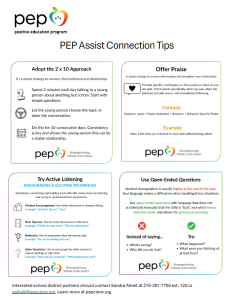Building Connection and Empowering Teachers: Four Simple Strategies from PEP Assist

When working with children who have severe mental health diagnoses or who have significant social emotional challenges, it can be difficult to form meaningful relationships. But building connection is critical. And when there is no connection, it can wreak havoc on a student’s success and on the entire classroom environment. Our team at PEP Assist sees this dynamic all the time in the schools and classrooms where they provide consultation services.
“The schools we support are regularly working with young people who have challenges like autism, conduct problems, ADHD and/or anxiety,” said Sandra Alheit, director, PEP Assist. “We use an ecological approach that emphasizes both the individual and the environment and the relationship between the two.”
The outcomes speak for themselves. Ninety-three percent of the students supported by PEP Assist remained in their original educational setting or were moved to a less restrictive environment.
Strategies for Building Connection
This year, Chris Ohlemacher, a PEP Assist consultant specialist working with a school in a Cleveland-area district, recognized that there was a need to strengthen the connection students felt with their teachers. He also knew there were some simple strategies that could make a big difference. In collaboration with Sandra Alheit, he developed a series of simple tips to provide to staff to help them build deeper connections to students. The school’s principal distributed them monthly as part of an all-staff bulletin.
The 2 x 10 Approach
For this approach, teachers spend two minutes (that’s the “2”) each day talking to a young person about anything but school. It’s easiest to begin with simple questions. The young person should choose the topic or steer the conversation. The teacher should continue this practice for 10 days (that’s the “10”). The consistency and nature of the conversation helps the young person understand that this relationship can be a stable one.
Behavior-Specific Praise
Most everyone understands that praise can help improve relationships, but there is a simple way to make praise even more effective. Make sure your praise is specific, contingent, and on-time. Here’s what the “formula” looks like:
Formula
Student’s name + Praise statement + Behavior = Behavior-specific praise
Example
Marc, I like the way you returned to your seat without being asked.
Active Listening
Active listening allows a student to openly share their perspective, which will help build trust. There are several ways you can encourage and elicit conversation from students.
Minimal Encouragement
Use this technique when someone is already talking to encourage them to continue. An example would be, “Uh-huh,” or “I see.”
Door Openers
This technique is helpful to use when inviting a person to talk more. You can say something like, “I’d like to hear more,” or “Tell me about that.”
Reflection
You can use this technique to summarize what the person said, which helps them understand that you are listening. For example, you might say something like, “So, you’re feeling left out.”
Open Questions
Use this technique to encourage the other person to express their feelings or share more. You can say something like, “How did you respond?” or “What happened next?”
Non-Judgmental, Open-Ended Questions
Student dysregulation is usually higher at the end of the school year, which can challenge teachers and other adults in a child’s life. The language you use as you handle these tricky situations can make a difference. When addressing issues, use open-ended questions that don’t imply the student is “bad.” This will help the student keep his or her defenses down and allow for genuine processing of the occurrence.
For instance, instead of asking a child, “Why did you do that?” ask, “What were you thinking at that time?”
Printable
These simple strategies are not just helpful in a classroom setting, but can help anyone who works with (or lives with) children. Want an easy way to remember these tips? Download and print these strategies and hang them somewhere you can see them.
About PEP Assist
PEP Assist customizes consultation services so that young people who have difficulties regulating emotions, severe mental health challenges, autism, and other special needs can be served – and ultimately thrive – in their schools and communities. Services include whole classroom support, individual student support and start-up support.
Learn more on our website. Interested school district partners should contact Sandra Alheit at 216-361-7760 ext. 120 or via email.

